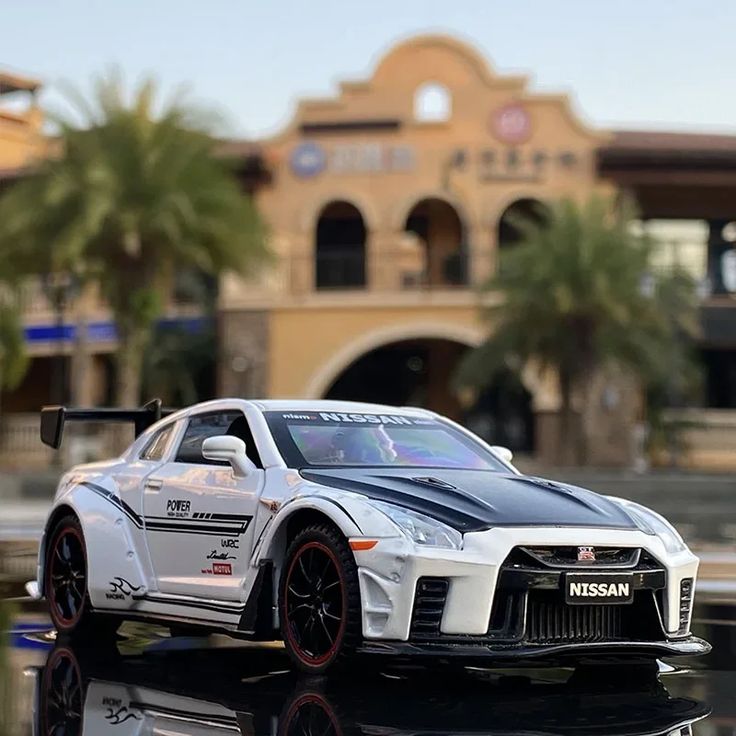In the world of automotive performance, few names resonate as powerfully as the Nissan GTR racing model. This celebrated vehicle represents not just a mode of transportation but a potent blend of speed, engineering mastery, and racing heritage. In this article, we will explore the evolution of the Nissan GTR (Japanese:日産GTR) racing model, tracing its lineage from its early days to the modern marvel it has become. We’ll cover the vehicle’s technological advancements, design philosophies, and its impact on the racing community.

The Genesis of the Nissan GTR Racing Model
The story of the Nissan GTR racing model begins in the late 1960s, specifically with the introduction of the Nissan Skyline GT-R in 1969. This initial model laid the groundwork for what would become an iconic racing pedigree. The GT-R designation signifies “Gran Turismo Racer,” and from the outset, Nissan intended this model to compete fiercely on the track.
- The Skyline GT-R quickly gained acclaim for its exceptional handling and performance, setting the stage for future iterations.
- Key features that contributed to its success included a lightweight design, a potent inline-six engine, and advanced aerodynamics for its time.
- It laid the groundwork for subsequent models, as Nissan continued to foster a deep commitment to innovation and racing excellence.
The early success of the Nissan GTR racing model set a high bar for its successors, making it a model that both enthusiasts and casual fans could rally around.
Advancements in Engineering: Turbos and All-Wheel Drive
As the Nissan GTR car model evolved, so too did its engineering. One of the most significant advancements came in the mid-1980s when Nissan introduced turbocharging technology into the model. This jump in sophistication allowed the GTR to deliver unparalleled power-to-weight ratios.
- The introduction of the RB26DETT engine in the R32 Skyline GT-R revolutionized performance with its twin-turbo inline-six configuration.
- Coupled with an active all-wheel-drive system known as ATTESA, the GTR provided thrilling acceleration and superior handling, making it competitive on circuits worldwide.
- This potent combination cemented the GTR’s reputation within motorsport, allowing it to dominate events and capturing numerous championships, which would eventually solidify its legacy.
These engineering feats not only enhanced the speed of the Nissan GTR racing model but also ensured its unwavering reliability, crucial for the rigors of racing.

The Evolution of Design: From Classic to Modern
The aesthetics of the Nissan GTR racing model have undergone drastic changes throughout its history, reflecting contemporary design trends while retaining the core elements that fans love. Here are some key points highlighting its evolution:
- Functional Origins: Early versions of the Nissan GTR prioritized a functional approach, focusing on designs that maximized performance. These models were characterized by their utilitarian aesthetics, emphasizing practicality over style.
- Aggressive Evolution: As time progressed, newer iterations of the GTR began to embrace a more aggressive and aerodynamic profile. This shift not only improved the vehicle’s performance but also enhanced its visual appeal, making it stand out on both the racetrack and the streets.
- Material Advancements: Today’s models, particularly the R35 GTR, utilize advanced materials like carbon fiber. This innovative use of materials significantly reduces the vehicle’s weight, enhancing both speed and agility while also bolstering its structural integrity.
- Balancing Form and Function: The current design of the Nissan GTR exemplifies a harmonious blend of form and function. This balance has ensured that the GTR remains relevant in a competitive market, appealing to both racers seeking high performance and automotive enthusiasts who value style and aesthetics.
- Cultural Icon: Over the years, the Nissan GTR has transformed into a cultural icon, representing the pinnacle of Japanese engineering and design. Its evolving aesthetics continue to capture the hearts of fans worldwide, ensuring its legacy endures.
Racing Heritage: The R32, R33, and R34 Dominance
The roots of the Nissan GT-R’s racing legacy are deeply embedded in the remarkable achievements of the R32, R33, and R34 models. Here’s how these iterations shaped the motorsport landscape:
- R32 – The Birth of a Legend: The R32, often dubbed “Godzilla” in Australia, made waves in the early 1990s. Its impressive performance led to multiple victories in local and international racing competitions, setting groundbreaking benchmarks for production cars and establishing the GT-R as a formidable force on the racetrack.
- R33 – Building on Success: Following in the footsteps of its predecessor, the R33 model took the GT-R legacy further by refining the car’s design. It introduced enhanced handling and advanced technology features, enabling drivers to push their performance boundaries and solidify the GT-R brand’s dominance in the Group A racing arena.
- R34 – Cultural Icon: The R34 elevated the GT-R’s status beyond motorsports fame. Its appearance in iconic films and video games greatly contributed to its cult following, showcasing not only its racing prowess but also its cultural significance among car enthusiasts.
These legendary GTR racing models captivated audiences on the track and played a pivotal role in cementing the GT-R’s status as an automotive icon.
Embracing Technology: The GTR in the Digital Age
With the dawn of the new millennium, the Nissan GTR racing model embraced technology in unprecedented ways. The integration of advanced digital tools has revolutionized both the performance of these vehicles on the track and their adaptability for everyday consumers.
- Agility and Control: One of the standout innovations is Nissan’s groundbreaking Super-HICAS (High Capacity Actively Controlled Steering) system. This technology enhances the vehicle’s agility by adjusting the rear-wheel steering based on speed and turning angle, providing drivers with unparalleled control and responsiveness during high-speed maneuvers.
- Sophisticated Telemetry Systems: Another significant advancement is the incorporation of sophisticated telemetry systems. These systems empower racers to collect and analyze vital data in real time, allowing them to make precise adjustments to optimize vehicle performance according to specific track conditions and driving styles.
- Consumer-Oriented Features: Beyond the racetrack, everyday consumers benefit immensely from features such as Nissan’s innovative multimedia and navigation systems. These high-tech solutions not only enhance the driving experience but also integrate seamlessly with the performance demands of the GTR, offering a perfect blend of luxury and functionality.
This synergy of traditional racing pedigree and cutting-edge technology has positioned the Nissan GTR racing model as a formidable competitor at the highest levels of motorsports, ensuring its legacy as a leader in automotive innovation.
The Community and Culture Surrounding the GTR
Beyond the technical aspects, the Nissan GTR racing model has fostered a passionate community of enthusiasts, owners, and racers that share a common love for speed and precision.
- Automotive clubs and online forums serve as platforms for GTR fans to connect, share tuning tips, and celebrate their mutual appreciation for this extraordinary model.
- Events like track days and car meets allow owners to showcase their vehicles, with some models heavily modified to push the boundaries of performance further.
- The strong community also contributes to the preservation and continued evolution of the GTR, ensuring that each model’s legacy is celebrated and remembered.
This vibrant culture surrounding the Nissan GTR racing model is testament to its impact not just as a car, but as a symbol that unites a diverse array of motor enthusiasts.
Future Prospects: The Next Generation of the GTR
As automotive technology continues to advance, speculation surrounding the future of the Nissan GTR racing model has fueled excitement and intrigue among enthusiasts. Here are key points to consider regarding its next iteration:
-
Hybrid Technology Exploration: Rumors suggest that the next generation of the GTR may embrace hybrid technology. This would not only enhance performance metrics but also reflect a growing commitment to environmental responsibility, marrying speed with sustainability.
- Lightweight Materials and Advanced Aerodynamics: There is a strong emphasis on utilizing lightweight materials and innovative aerodynamic designs. These advancements are crucial for optimizing the GTR’s speed and handling characteristics, ensuring it remains true to its racing heritage while pushing the boundaries of automotive performance.
- Return to Competitive Racing: Nissan appears poised to return the GTR to competitive racing at the highest levels. This ambition positions the GTR as a serious contender in motorsports, reigniting its legacy in the racing community.
- Excitement and Innovation: The anticipation surrounding the next chapter in the GTR’s legacy is intense. Enthusiasts are eager to see how Nissan will blend cutting-edge technology with the iconic performance that has defined the GTR for decades, promising another generation of thrilling innovation.
Conclusion
The Nissan GTR racing model embodies more than just a car; it represents a profound commitment to speed, power, and performance that has evolved dramatically over decades. From its storied beginnings on the racetrack to the groundbreaking technological advancements that followed, the GTR has cultivated a passionate and dedicated community of enthusiasts. This loyal support, combined with Nissan’s relentless pursuit of excellence, has solidified the GTR’s place in automotive history as an icon of both innovation and heritage.
As we look to the future, it is clear that the indomitable spirit of the Nissan GTR racing model will continue to inspire and excite generations to come. Its legacy is not merely confined to its impressive specifications; it embodies a culture of racing that transcends mere competition.
With this exploration of its evolution, we invite you to dive deeper into the fascinating world of the Nissan GTR racing model—an automotive icon that truly celebrates the art of speed, precision, and relentless ambition. The journey of the GTR is a testament to the enduring passion for performance, urging car enthusiasts and racers alike to revere this magnificent machine.


